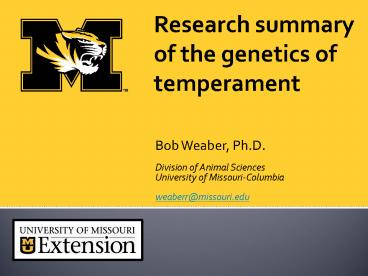Research summary of the genetics of temperament
1 / 24
Title:
Research summary of the genetics of temperament
Description:
Bob Weaber, Ph.D. Division of Animal Sciences University of Missouri-Columbia weaberr_at_missouri.edu –
Number of Views:82
Avg rating:3.0/5.0
Title: Research summary of the genetics of temperament
1
Research summary of the genetics of temperament
- Bob Weaber, Ph.D.
- Division of Animal Sciences
- University of Missouri-Columbia
- weaberr_at_missouri.edu
2
Overview
- Why is temperament important?
- Measures of temperament
- Genetic and phenotypic relationships
- Growth
- Feed intake, feed efficiency (RFI, FCR, FE)
- Meat quality
- Animal health and well being
- Chronic stress, immune response
3
Why is temperament important?
- Animal well being
- Handler well being/safety
- Mean age of operator increasing
- Family operations
- Facility construction and maintenance
- Performance in correlated traits
- Can we improve profitability?
4
Measures of temperament
- Chute score (subjective)
- Measured on individual animal
- 1 (docile)-6 (very aggressive) (BIF Guidelines)
- Pen score (subjective)
- 1-5 animals in pen
- 1 calm, 5 very aggressive
- Exit velocity or flight speed (objective)
- Chute tensometer (g force) (objective)
5
Exit Velocity
Infrared Eye
Infrared Eye
6 ft
6 ft
Chute
6
Exit Velocity
7
Distribution of Avg. Chute Score
8
Distribution of Exit Velocity (m/sec)
9
Is it heritable?
- Temperament is heritable
- Chute Score (subjective) h2 0.26-0.40 (Beckman
et al., 2007 Weaber, 2007 Burrow and Corbet,
2000) - Pen Score h2 0.15
- (Weaber Creason, 2007)
- Exit Velocity (objective)
- Single measure h2 0.35 (Weaber Creason,
2007 Burrow, 2001) - Avg. of gt2 measures h2 0.44-0.50 (Burrow,
2001)
10
Heritabilities and Correlations
Estimate (Std Error) EV PS
EV 0.35 (0.078) 0.20
PS 0.28 (0.825) 0.15 (0.058)
Heritability on diagonal, phenotypic correlation
above, genetic correlation below
11
Breed differences exist
- Bos indicus more excitable than B. taurus
- (Fordyce et al., 1988 Voisinet et al. 1997)
- Differences among B. taurus breeds
- (Gauly et al., 2002 Morris et al., 1994)
- Within breed differences exist for a variety of
parameters and are consistent across breeds.
12
Temperament and Growth
- Animals with faster flight times and higher pen
score had phenotypically - Lighter weaning weights
- Less ADG during back grounding period (55 d)
- Lighter placement weights at induction to feed
yard - Less ADG, DMI (p lt 0.10)
- (Weaber and Creason, 2007 Creason and Weaber,
2007)
13
Temperament and Feed Efficiency
- Exit Velocity (flight speed) genetically
correlated with - Feeding duration 0.42 0.26
- Dry matter intake -0.11 0.26 (rp -0.35)
- Residual feed intake -0.59 0.45 (rp 0)
- Feed conversion ratio 0.40 0.26 (rp 0)
Nkrumah et al., 2007
14
Temperament and Meat Quality
- Trait Genetic
Correlation w/ Flight Time - Carcass Wt. 0.05
- Retail Yield 0.11
- Marbling -0.05
- Shear Force -0.48
- Meat Color -0.18
- (Burrow, 2003)
- Phenotypic correlations shown between Temperament
and Production Traits FI, BW, ADG, WBSF (Weaber
et al., 2007 Curley et al., 2006 Burrow 2003) - Less desirable temperament associated with
elevated stress hormones and reduced response to
vaccination (Curley et al., 2006 Oliphant et
al., 2006)
15
Temperament and Tenderness
Animals (n3,042) WBSF (n2,819) EV1 (n917)
EV2 (n976) Pedigree (n13,418) CG (n176)
Variable VP Std. Error VG Std. Error h2 Std. Error
Shear Force 57.24 1.70 11.11 3.70 0.19 0.06
Velocity 0.23 0.03 0.09 0.03 0.39 0.09
Correlation (SE) Shear Force Velocity 1
Shear Force -0.10 (0.20)
Velocity 1 -0.08 (0.06)
Genetic Correlation Phenotypic Correlation
Taxis and Weaber, 2010
16
Temperament and Animal Health
- Animals with poor temperament
- High exit velocity (small flight time)
- High chute (or crush) scores
- Typically have higher
- Serum cortisol (at weaning, placement in feed
lot, and during feeding period) (Fell et al.
1999 Curley et al. 2006 Oliphint et al. 2006) - Higher morbidity (Fell et al., 1999)
- Lower ADG (Fell et al., 1999 Nkrumah et al.,
2007 Weaber and Creason, 2007) - Temperament thought to contribute to chronic
stress
17
Temperament and Animal Health
Curley et al., 2006
18
Temperament and Animal Health
Curley et al., 2006
19
Temperament and Animal Health
Curley et al., 2006
20
Temperament and Animal Health
Curley et al., 2006
21
Temperament and Animal Health
Oliphint et al. 2006
22
Temperament and Animal Health
Oliphint et al. 2006
23
Conclusions
- Temperament
- Negatively associated with
- Handler and animal safety
- Growth (placement weights, ADG)
- Meat quality (WBSF, meat color)
- Immune function
- Positively associated with
- Metabolic indicators of stress
- Morbidity
24
- Questions
- Thank You!































